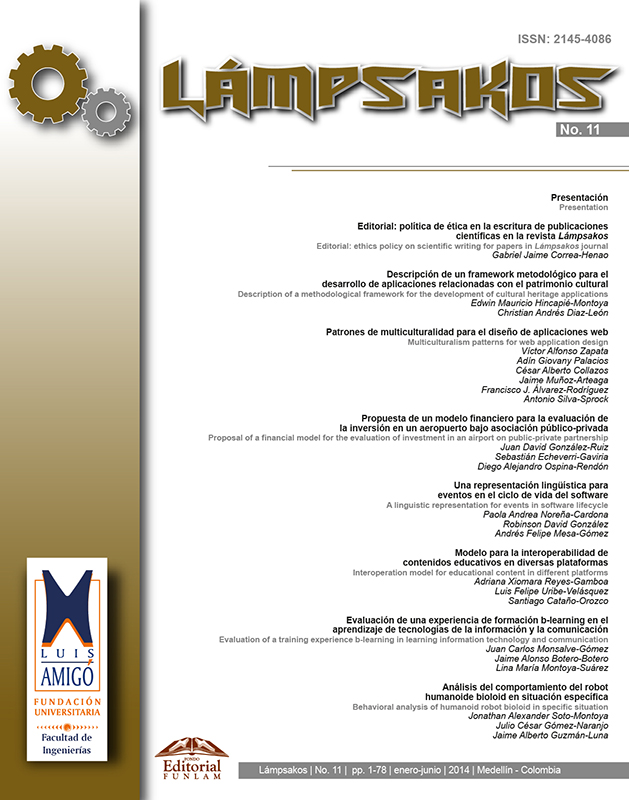Description of a Methodological Framework for the Development of Cultural Heritage Applications
DOI:
https://doi.org/10.21501/21454086.1136Keywords:
Methodological Framework, Cultural Heritage, Virtual Reality, Augmented Reality, Serious GamesAbstract
Preserving and spreading spaces is a social function that should maintain together the people and cannot be less important than progress and development. Technology plays a media facilitator role allowing experiencing different spaces and places historically important but physically inaccessible for his disappearance. Recently, applications have been developed which revive cultural heritage using technologies such as virtual reality, augmented reality and serious games. However, most are case studies reporting work in a specific subject and a methodological framework to guide and facilitate the development of such applications has not been proposed. In this paper, a conceptual methodological framework which guides the development of cultural heritage applications while maximizing the users' cultural heritage learning is proposed.Downloads
References
Z. Noh, M. Sunar & Z. Pan. “A review on augmented reality for virtual heritage system”. Proceedings of the 4th International Conference on E-Learning and Games: Learning by Playing. Game-based Education System Design and Development. Edutainment '09, Springer-Verlag, pp. 50-61, 2009.
M. Mortara, C. Catalano, F. Bellotti, G. Fiucci, M. Houry-Panchetti & P. Petridis. Learning cultural heritage by serious games. Journal of Cultural Heritage, Volumen 6, 2013.
Z. Mikovec, P. Slavik & J. Zara. Cultural heritage, user interfaces and serious games at CTU prague. International Conference on Virtual Systems and Multimedia, pp. 211-216, 2009.
F. Windhager & E. Mayr. Cultural heritage cube: A conceptual framework for visual exhibition exploration. Proceedings of the 16th International Conference on Information Visualisation. IV '12, IEEE Computer Society, pp. 540-545, 2012.
A. Abate, G. Acampora & S. Ricciardi. An interactive virtual guide for the art based visit of archeological sites. Journal of Visual Languages and Computing, Volume 22, pp. 415-425, 2011.
A. Foni, G. Papagiannakis & N. Magnenat-Thalmann. A taxonomy of visualization strategies for cultural heritage applications. Journal on Computing and Cultural Heritage, Volumen 3, Numero 1, pp. 1-21, 2010.
S. Hesel. Virtual Reality: Theory, Practice and Promise. First Edition. Ed. Information Today Inc., 1991.
H, Kaufmann. Collaborative augmented reality in education. ImaginaConference 2003, Monaco Mediax pp. 50-61, 2003.
E. Hooper-Greenhill. Measuring learning outcomes in museums archives and libraries: The learning impact research project (LIRP). International Journal of Heritage Studies, Volume 10, Número 2, pp. 151-174, 2004.
M. Ott y F. Pozzi. Towards a New Era for Cultural Heritage Education. Journal Computers in Human Behavior, Volumen 27, Número 4, pp. 1365 – 1371, 2011.
Rua, H. y Alvito, P. Living the past: 3D models, virtual reality and game engines as tools for supporting archaeology and the reconstruction of cultural heritage – the case-study of the Roman villa of Casal de Freiria. Journal of Archaeological Science, Volumen 38, Número 12, pp. 3296 – 3308, 2011.
J.-G. Han and K.-W. Park and Ky.-J. Ban and E.-K. Kim. Cultural Heritage Sites Visualization System based on Outdoor Augmented Reality. Volumen 4, pp. 64 – 71, 2013.
J. Abu, P. Shireen y M. Mahmud. User Requirements for Virtual Reality in Architectural Heritage Learning. International Journal of Interactive Digital Media, Volumen 1, Número 1, pp. 37 – 45, 2013.
L. Pujol y E. Champion. Evaluating Presence in Cultural Heritage Projects. International Journal of Heritage Studies, Volumen 18, Numero 1, pp. 83 – 102, 2012.
F. Bruno, S. Bruno, G. De Sensi, M.-L. Luchi, S. Mancuso y M. Muzzupappa. From 3D reconstruction to virtual reality: A complete methodology for digital archaeological exhibition. Journal of Cultural Heritage, Volumen 11, Número 1, pp. 42 – 49, 2010.
Downloads
Published
How to Cite
Issue
Section
License
In accordance with national and international copyrights, as well as publishing policies of "Fundación Universitaria Luis Amigó" and its Journal "Lámpsakos" (indexed with ISSN : 2145-4086), I (we ) hereby manifest:1. The desire to participate as writers and submit to the rules established by the magazine publishers.
2. The commitment not to withdraw the manuscript until the journal finishes the editing process of the ongoing issue.
3. That article is original and unpublished and has not been nominated or submitted together in another magazine; therefore, the rights of the article in evaluation have not been assigned in advance and they do not weigh any lien or limitation for use.
4. The absence of conflict of interest with commercial institution or association of any kind
5. The incorporation of the quotes and references from other authors, tending to avoid plagiarism. Accordingly, the author affirms that the paper being published do not violate copyright, intellectual property or privacy rights of third parties. Morover, if necessary there is a way of demonstrating the respective permits original copyright to the aspects or elements taken from other documents such as texts of more than 500 words, tables, graphs, among others. In the event of any claim or action by a third party regarding copyright on the article, the author (s) will assume full responsibility and come out in defense of the rights herein assigned. Therefore, for all purposes, the Journal "Lámpsakos" of the "Fundación Universitaria Luis Amigó" acts as a third party in good faith.
6. In the event of the publication of the article, the authors free of charge and on an exclusive basis the integrity of the economic rights and the right to print, reprint and reproduction in any form and medium, without any limitation as to territory is concerned, in favor of the Journal "Lámpsakos" of the "Fundación Universitaria Luis Amigó".








